Abstract
Exposition of Cupriavidus necator to ethanol or hydrogen peroxide at the beginning of the stationary phase increases poly(3-hydroxybutyrate) (PHB) yields about 30%. Hydrogen peroxide enhances activity of pentose phosphate pathway that probably consequently increases intracellular ratio NADPH/NADP+. This effect leads to stimulation of the flux of acetyl-CoA into PHB biosynthetic pathway and to an increase of enzymatic activities of β-ketothiolase and acetoacetyl-CoA reductase while activity of PHB synthase remains uninfluenced. During ethanol metabolisation, in which alcohol dehydrogenase is involved, acetyl-CoA and reduced coenzymes NAD(P)H are formed. These metabolites could again slightly inhibit TCA cycle while flux of acetyl-CoA into PHB biosynthetic pathway is likely to be supported. As a consequence of TCA cycle inhibition also less free CoA is formed. Similarly with hydrogen peroxide, activities of β-ketothiolase and acetoacetyl-CoA reductase are increased which results in over-production of PHB. Molecular weight of PHB produced under stress conditions was significantly higher as compared to control cultivation. Particular molecular weight values were dependent on stress factor concentrations. This could indicate some interconnection among activities of β-ketothiolase, acetoacetyl-CoA reductase and PHB molecular weight control in vivo.





Similar content being viewed by others
References
Ayub ND, Pettinari MJ, Ruiz JA, Lopez NI (2004) A polyhydroxybutyrate-producing Pseudomonas sp. isolated from antarctic environments with high stress resistance. Curr Microbiol 49:170–174
Bradford MM (1976) A rapid and sensitive method for the quantitation of microgram quantities of protein utilizing the principle of protein-dye binding. Anal Biochem 72:248–254
Brandl H, Gross RA, Lenz RW, Fuller RC (1988) Pseudomonas oleovorans as a source of poly(beta-hydroxyalkanoates) for potential application as a biodegradable polyester. Appl Environ Microb 54:1977–1982
Breedveld MW, Dijkema C, Zevenhuizen LPTM, Zehner AJB (1993) Response of intracellular carbohydrates to NaCl shock in Rhizobium leguminosarum biovar triforii TA-1 and Rhizobium meliloti SU-47. J Gen Microbiol 139:3157–3163
Cabiscol E, Tamarit J, Ros J (2000) Oxidative stress in bacteria and protein damage by reactive oxygen species. Intern Microbiol 3:3–8
Doi Y, Yasushi Y, Naoyuki K, Schiegeo N, Masaya H, Yoshida Y, Kimura H (1992) Synthesis and degradation of polyhydroxyalkanoates in Alcaligenes eutrophus. FEMS Microbiol Rev 125:103–108
Dorotina NV, Ezhov VA, Trotsenko YA (2008) Growth of Methylosinum trichosporium OB3b on methane and poly-beta-hydroxybutyrate biosynthesis. Appl Biochem Microb 44:182–185
Gerngross TUD, Martin P (1995) Enzyme-catalysed synthesis of poly[(R)-(−)-3-hydroxybutyrate]: formation of macroscopic granules in vitro. Proc Natl Acad Sci USA 92:6279–6283
Izawa S, Maeda K, Miki T, Mano J, Inoue Y, Kimura A (1998) Importance of glucose 6-dehydrogenase in the adaptive response to hydrogen peroxide in Saccharomyces cerevisiae. Biochem J 330:811–817
Kadouri D, Jurkevitch E, Okon Y (2003) Involvement of the reserve material poly-beta-hydroxybutyrate in Azospirillum brasilense stress endurance and root colonization. Appl Environ Microb 69:3244–3250
Kadouri D, Jurkevitch E, Okon Y, Castro-Sowinski S (2005) Ecological and agricultural significance of bacterial polyhydroxyalkanoates. Crit Rev Microbiol 31:55–67
Kamnev AA, Tugarova AV, Antonyuk LP (2007) Endophytic and epiphytic strains of Azospirillum brasilense respond differently to heavy metal stress. Microbiol 76:809–811
Kawaguchi Y, Doi Y (1992) Kinetics and Mechanism of Synthesis and Degradation of Poly(3-hydroxybuytyrate) in Alcaligenes eutrophus. Macromolecules 25:2324–2329
Kessler B, Wilholt B (1999) Poly(3-hydroxyalkanoates. In: Flickinger MC, Drew SW (eds) Encyclopedia of bioprocess technology–fermentation, biocatalysis and bioseparation. Wiley, New York, pp 2024–2040
Kessler B, Wilholt B (2001) Factors involved in the regulatory of polyhydroxyalkanoate metabolism. J Biotech 86:97–104
Kichise T, Fukui T, Yoshida Y, Doi Y (1999) Biosynthesis of polyhydroxyalkanoates (PHA) by recombinant Ralstonia eutropha and effect of PHA synthase activity on in vivo PHA biosynthesis. Intern J Biol Macromol 25:69–77
Kimura H, Ohura T, Matsumoto T, Ikaraski T (2008) Effective biosynthesis of poly(3-hydoxybutyrate-co-4-hydroxybutyrate) with high 4-hydroxybutyrate fractions by Wautersia eutropha in the presence of α-amino acids. Polymer Int 57:149–157
Kusaka S, Abe H, Lee SY, Doi Y (1997) Molecular mass of poly[(R)-3-hydroxybutyric acid] produced in a recombinant Escherichia coli. Appl Microbiol Biotechnol 47:140–143
Lee SY, Choi JI, Han K, Song JY (2003) Removal of endotoxin during purification of poly(3-hydroxybutyrate) from gram-negative bacteria. Appl Environ Microb 65:2762–2764
Natarajan K, Kishore L, Babu CR (1995) Sodium-chloride stress results in increased poly-beta-hydroxybutyrate production in Rhizobium DDSS-69. Microbios 82:95–107
Nenkov I, Stahlhut G, Kusian B, Mitov I, Bowien B (2008) Bioinformatical sequence analysis of the product of adjacent zwf and edd2 operons of Ralstonia eutropha H16. Biotechnol Biotechnol Eq 22:588–597
Obruca S, Marova I, Svoboda Z, Mikulikova R (2010) Use of controlled exogenous stress for improvement of poly(3-hydroxybutyrate) production in Cupriavidus necator H16. Folia Microbiol 55(2), XX–XX (in press)
Oeding V, Schlegen HG (1973) β-Ketothiolase from Hydrogenomonas eutropha H16, and its significance in the regulation of poly-β-hydroxybutyrate metabolism. Biochem J 134:243–248
Reinecke F, Steinbuchel A (2009) Ralstonia eutropha Strain H16 as a model organism for PHA metabolism and for biotechnological production of technically interesting biopolymers. J Mol Microbiol Biotechnol 16:91–102
Romanova AK, Vedenina IY, Nozhevnikova AN (1970) Investigation of products of short-term chemosynthesis and certain enzymes of the reductive pentose phosphate cycle in hydrogen bacteria Hydrogenomonas eutropha. Microbiol 39:479–483
Rowley DL, Wolf RE Jr (1991) Molecular characterization of the Escherichia coli K-12 zwf gene encoding glucose 6-phosphate dehydrogenase. J Bacteriol 173:968–977
Sagisaka S (1972) Decrease of glucose 6-phosphate and 6-phosphogluconate dehydrogenase activities in the xylem of Populus gelrica on budding. Plant Physiol 50:750–755
Senior PJ, Dawes EA (1971) Poly-β-hydroxybutyrate biosynthesis and the regulation of glucose metabolism in Azotobacter beijerlinkii. Biochem J 125:55–66
Sharma L, Panda B, Sigh A, Mallick N (2006) Studies on poly-beta-hydroxybutyrate synthase activity of Nostoc muscorum. J Gen Appl Microb 52:209–214
Sigler K, Chaloupka J, Brozmanova J, Stadler N, Hofer M (1999) Oxidative stress in Microorganisms. Folia Microbiol 44:587–624
Sim SJ, Snell KD, Hogan SA, Stubbe J, Rha C, Sinskey AJ (1996) PHA synthase activity controls the molecular weight and polydispersity of polyhydroxyalkanoates in vivo. Nat Biotech 15:63–67
Wales MR, Fewson CA (1994) NADP-dependent alcohol dehydrogenase in bacteria and yeast: purification and partial characterization of the enzymes from Acinetobacter calcoaceticus and Sacharomyces cerevisiae. Microbiol 140:173–183
Yamato S, Sugihara H, Wakabayashi H, Shimada K (1989) A simple spectrophotometric determination of acetyl-coenzyme A using thermo-and pH-stable phosphotransacetylase. Anal Let 22:573–584
Zhao YH, Li HM, Qin LF, Wang HH, Chen GQ (2007) Disruption of the polyhydroxyalkanoate synthase gene in Aeromonas hydrophila reduces its survival ability under stress conditions. FEMS Microbiol Lett 276:34–41
Acknowledgments
This work has been supported by project MSM 0021630501 and FR 2613/G4/2009 of Czech Ministry of Education.
Author information
Authors and Affiliations
Corresponding author
Rights and permissions
About this article
Cite this article
Obruca, S., Marova, I., Stankova, M. et al. Effect of ethanol and hydrogen peroxide on poly(3-hydroxybutyrate) biosynthetic pathway in Cupriavidus necator H16. World J Microbiol Biotechnol 26, 1261–1267 (2010). https://doi.org/10.1007/s11274-009-0296-8
Received:
Accepted:
Published:
Issue Date:
DOI: https://doi.org/10.1007/s11274-009-0296-8




